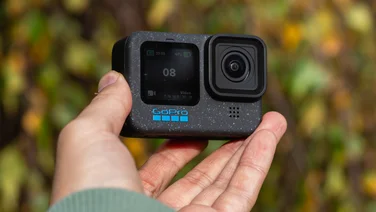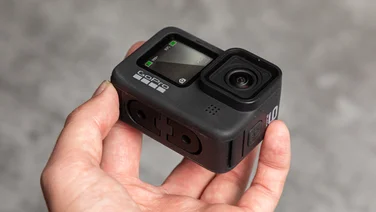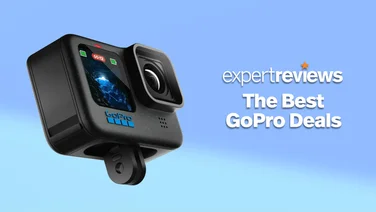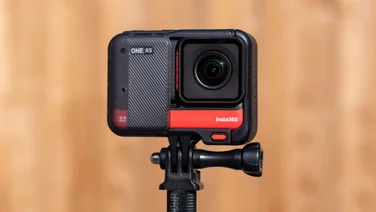To help us provide you with free impartial advice, we may earn a commission if you buy through links on our site. Learn more

- Wearable camera and action camera in one
- Articulating touchscreen
- Good range of shooting modes
- No removable microSD card slot
- Battery is also not removable
- No 4K video recording
Insta360 might be best known for its 360-degree cameras but, thanks to its modular and wearable cameras, it’s also making inroads into traditional action camera markets. The Insta360 Go 3 is the firm’s latest offering in this segment and it’s one of the cleverest action cameras I’ve ever seen.
Ostensibly, the Insta360 Go 3 is the follow-up to the Go 2 – a wearable camera packaged in an ingenious charging case – and it takes things to the next level, adding a full-colour articulating touchscreen to the charging case, higher-resolution video capture plus a whole host of new features. It may not be the best action camera you can buy, but it is one of the most versatile.
Insta360 Go 3 review: What do you get for the money?
The Insta360 Go 3 is not your usual GoPro-style camera. The main camera part is contained within a tiny, thumb-sized unit which is small enough to be mounted in a number of different ways.
One novel example is the magnetic pendant that comes in the box. This allows the Go 3 to be attached to your clothing – you simply hang the pendant around your neck behind your shirt and the camera magnetically attaches over the top of your clothing.

The more conventional clip mount can be used to attach the camera to a peaked hat, and this also has a sticky pad that allows the camera to be stuck firmly to a surface.
The star of the show, however, is the charging case, which Insta360 calls the “Action Pod”. Slot the camera into this and the Insta360 Go 3 turns into a GoPro clone, complete with a 2.2in articulating touchscreen and booster battery.The box also contains a magnetic clip-on bracket, which can be attached to a tripod (or a small stick, posable stand, also supplied in the box) via a 1/4in thread, or you can purchase a separate accessory with GoPro-style mounting prongs, opening up a whole world of options.
The price for all this is around £380 for the model with 32GB of storage built in, which is comparable to the GoPro Hero 11 Black (£400) but a touch more expensive than Insta360’s own One RS modular camera, the One RS 4K (around £280). If you want more storage for your video clips you’ll be spending even more, though, because the camera has no microSD card slot. The 64GB model is £400 and the £128GB model is £430.
Where the Insta360 One Go 3 falls down, certainly in comparison to other action cameras at around this price, is the recording resolution. Where cameras such as the Hero11 Black and the Insta360 One RS are capable of recording at 4K and above, the Go 3 is capped at 2.7K (2,720 x 1,536 at either 24, 25 or 30fps). That, however, is definitely a step up over the Go 3’s predecessor – the Go 2 could only capture video at 1440p.

As a bonus, though, the Insta360 Go 3 provides a wide selection of shooting modes, ranging from the usual timeshift, interval and slow motion modes, through to the new Freeform, which allows you to capture video that can be cropped to horizontal or vertical video modes in post. Also worth noting is that Insta360 has added a new loop mode, which makes this camera useful for anyone who wants to use the camera as a kind of cycling dashcam.
There’s also a new pre-recording mode, which continually buffers 10-, 15- or 30-second recordings so you’ll never miss an important moment. If funny cat videos are your thing or you don’t like recording long clips in the hope of capturing maybe 20 seconds of interesting video, this is the mode you want. See something interesting, hit record and the camera will have automatically captured the period immediately before you pressed the button. This does use up the battery much quicker than simply anticipating and planning your shots, though.
READ NEXT: The best GoPro to buy right now
Insta360 Go 3 review: What do we like about it?
I don’t think I’ve ever come across an action camera that’s as neatly or cleverly designed as the Insta360 Go 3. The ability to use it as both a wearable action camera or a regular action camera is, essentially, unsurpassed, and there aren’t all that many major drawbacks.
The touchscreen is both responsive and reasonably intuitive to use; the camera itself is water resistant to a depth of 5m, while the Action Pod case is IPX4 water resistant; and it’s not heavy or bulky, either, with the Go 3 weighing a mere 35.5g and the Action Pod a further 96.3g.

The battery life is pretty good, too, with the Go 3 lasting 45 minutes of 1080p recording at 30fps and the Go 3 and Action Pod rated at 2hrs 20mins (1080p at 30fps).
Image quality is pretty decent and Insta360’s FlowState image stabilisation is very impressive indeed. As with most action cameras, you need to be recording in daylight to make the most of it, but as long as you stick with well-lit outdoor activities – the sort of thing the Go 3 is designed to capture – you’ll see video footage that’s detailed and renders colours in a balanced, natural way – and you’ll find that the FlowState stabilisation works very well indeed.
One of the first things I did after taking the camera out of the box was to attach it to my running cap to see how it would cope with the extreme bouncing and juddering of my morning run. The results were very impressive: most of the bounce was smoothed out, and the end result was a very watchable clip. I found I was able to capture the best results by using the camera’s new Freeform mode (just double-click the camera’s built-in “button”), and this adds horizon levelling to FlowState stabilisation for a dead-level, super-smooth capture.

Video recorded in low light situations can look good, too, but you’ll need to be much more careful how you hold the camera. I found the image stabilisation struggled to maintain smoothness without introducing shimmering artefacts into clips, even when I was indulging in relatively gentle activities.
Insta360 Go 3 review: What could it do better?
There are a few weaknesses in the Insta360 Go 3’s feature set, the most obvious of which is the lack of 4K video recording. Depending on your requirements, though, this needn’t be a hindrance. Video quality is perfectly decent in good light and the camera’s flexibility means it’s usable in all sorts of scenarios.
Perhaps a bigger problem is the lack of expandable storage. The absence of a microSD card slot will be a problem if you plan on capturing lots of long clips while you’re out on the trail. You can free up space by transferring clips to your phone, of course, but this operation will use up battery life on both devices.

Furthermore, there’s no removable battery and while that’s understandable given how many features the camera squeezes in, it also means there’s a hard limit to how long you can use the camera for before it is out of commission. Unlike GoPro, or most other action cameras for that matter, you can’t simply precharge two or more batteries before you venture out and swap them to keep on trucking. Once this camera has run out of juice you won’t be able to use it until the battery in one or both units has recharged.
And, as with most action cameras, the list of resolutions and modes and the various limitations of the Go 3 can be bafflingly complex. How do you get the best-quality video? Do you record in standard Video mode, and set the camera to 2.7K resolution? Well, yes, but this limits you to 30fps, not the 50fps the camera is capable of, and it means you can’t use horizon levelling.
You want horizon levelling? You need to use the Freeform mode but this has the drawback of only recording in 1440p resolution (at 50fps) and the stabilisation and horizon levelling needs to be applied in post. Should you want to grab the clips off the camera directly, without putting it through the app or the Insta360 Studio desktop software, the footage will be very shaky.
READ NEXT: Best GoPro accessories to buy today
Insta360 Go 3 review: Should you buy one?
The Insta360 Go 3 is an ingenious camera. It’s well made and easy to use, and the design is impressively versatile. Image quality is pretty good, too and it’s stuffed with clever shooting modes.
However, it does have some limitations – notably the lack of a microSD card slot and removable battery and poor low-light image stabilisation. The price is pretty high, too, and puts it in the awkward position of being both more expensive than the modular Insta360 One RS and less capable, in terms of the resolution of its video capture.
The Insta360 Go 3 is ultimately a bit of a difficult product to recommend. It’s novel, well engineered and extremely clever – but it’s a tad too expensive and limited to recommend wholeheartedly.







